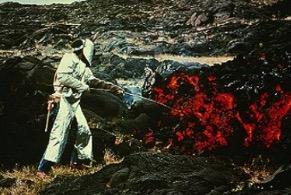Here's a chemical that you don't want to screw around with: sulfuric acid. The only thing good about it is that it is not volatile. The only thing bad about it is everything else.
And it's pouring out of the Kilauea volcano as we speak. Sort of.
Chemists generally hate using the stuff. The old expression "add acid to water" (1), although it applies to acids in general, is really reserved for sulfuric acid, which is 98% pure in the bottle. When it comes in contact with (all sorts of things) it reacts violently and can generate a whole lot of heat. One of these things is water. Sulfuric acid really loves water, so much so that if you place both a half-full beaker of water and one half-filled with concentrated sulfuric acid in a closed system and let it sit around for a few weeks the water beaker will be empty, having transferred its contents to the beaker with the sulfuric acid.
Sulfuric acid also loves clothing. No matter how careful you are, it is likely that your clothing will end up with small holes in it. Yet, this is less of a problem than one might think. It is no secret that we chemists are not known for our sartorial splendor. Not only doesn't it matter that we might walk around with holes in our clothing, but some of us actually think this looks pretty good. Polyester plaid shirts with holes and a striped tie was an especially badass look for a while. (I did, however, take issue with pants coming to a rest roughly midway between the ankles and knees.) Here's what one drop of sulfuric acid does to cotton.
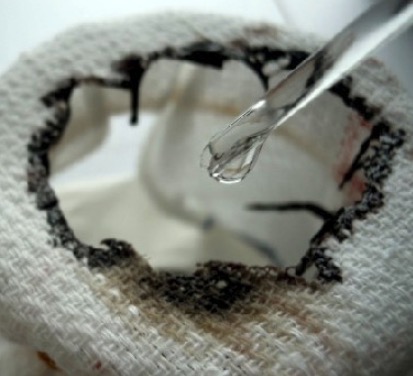
Volcano chemistry - What are you breathing?
Volcanoes put out ginormous amounts of a putrid-smelling gas called sulfur dioxide (SO2). Yet, the real danger in breathing volcano air is not SO2, which is bad enough, but rather sulfuric acid, H2SO4. But the chemistry doesn't add up. Sulfur dioxide does not turn into sulfuric acid when added to water. And very little sulfuric acid comes from the volcano itself. So, what's going on? Mother Nature is needed, not once, but twice. Once from water in the atmosphere and the other time sunlight and oxygen.
Step 1: A stinky gas turns into a weak acid
Sulfur dioxide, one of the most prevalent gases to be ejected from a volcano, reacts with water, but this makes sulfurous acid, which has the formula H2SO3. Even you art history majors can tell the difference. Where does the other oxygen come from? That's where sunlight and air come in.
SO2+H2O→H2SO3
Sulfur dioxide reacts with water to form sulfurous acid
Guess what, it's time for the dreaded chemistry lesson!! Stay with me here. It's not that bad.

Photo: DailyMail
(Just to show I remember 7th-grade chemistry let's assign charges to the atoms! Fun! For losers. Hydrogen is +1. Oxygen is -2 (don't ask why). So two hydrogen atoms combined with three oxygen atoms gives you a net charge of -4. To make the sulfurous acid neutral, sulfur must, therefore, be +4 - one of five different oxidation states in which it can exist (these can be interconverted by adding or removing electrons in a variety of chemical reactions. Don't ask about this either).
Step 2: A weak acid turns into a very strong one.
H2SO3 + O2 [catalyzed by sunlight] ------> H2SO4
It's not that I would recommend gargling with sulfurous acid, but compared to its +6 oxidation state comrade sulfuric acid, it's a box of Cap'n Crunch. More or less.
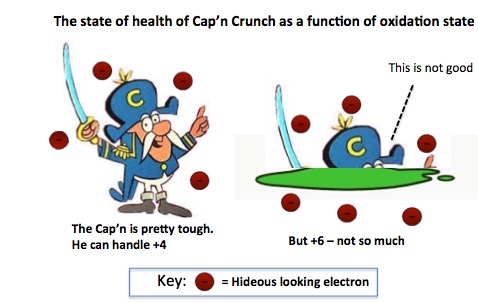
This is why if you are near a volcano you will feel a burning sensation - minuscule particles of sulfuric acid in your eyes, nose, and lungs. (2) To be avoided.
How hot is molten lava? And how do you measure the temperature?
Molten lava is crazy hot. Just look at the latest videos of it incinerating everything in its path. The lava pouring from Kilauea is 2,140 ºF, not too different from Bikram yoga. That's plenty hot. Just for laughs, here are the melting points of some common metals (in ºF). Lava won't melt every metal, but it takes care of its share.
- Gold - 1948
- Silver - 1763
- Lead - 621
- Iron - 2800
- Titanium - 3034
- Aluminum - 1221
And glass - ~ 2700
So, while you could theoretically take a glass thermometer, stroll over and stick it in the molten lava, this is not recommended. But something pretty close to this is done. There is a device called a thermocouple, which consists of twisted pieces of two different metals. When heated this will generate an electric current can be measured and will be indicative of the temperature. I volunteer you for this.
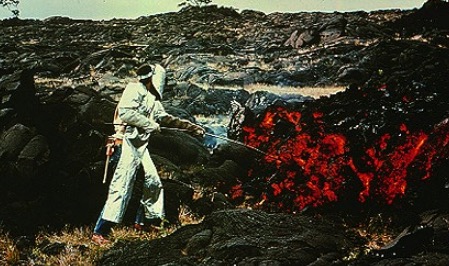
Lunatic measuring lava temperature in Hawaii, 1971. Photo: Hilo.hawaii.edu
Far better is the use of color, which is done from a distance. The color of the lava is related to its temperature by virtue of a godforsaken entity called the Stefan–Boltzmann law. On the surface it appears simple enough:

The Stefan-Boltzman law. Pure evil. But it allows one to measure temperature as a function of dark radiation, which is emitted by hot objects that do not give off or reflect visible light in the form of colors. There are actually people out there who understand this stuff. I am not one of them. If you ask me to explain this I will just hide under the bed. Source: Wikipedia
Somehow that gibberish above turns into this:
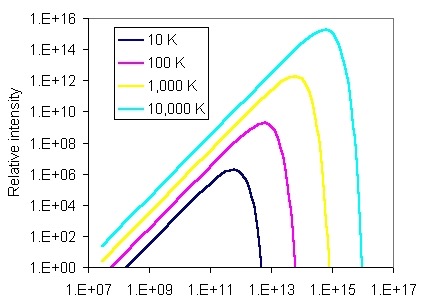
The frequency (x-axis) of the black body radiation of an object as a function of its temperature (y-axis). Source: jb.man.ac.uk
Other miscellaneous nastiness:
- Carbon dioxide isn't toxic at normal concentrations, but if there is too much of it all bets are off. Volcanoes give off huge amounts of the gas. Since CO2 is denser than air it can form a layer near the ground which can grow thicker. You wouldn't notice anything until the CO2 displaced enough oxygen to become quickly lethal, at which point your carbon footprint will cease to exist.
- Just what we don't need. Volcanoes give off all kinds of icky things, liquids, solids, and gases. Although water, carbon dioxide, and sulfur dioxide make up much of the gas, there are a few other things in there that we could easily do without.
- Hydrogen sulfide. About as toxic as hydrogen cyanide. The smell of rotten eggs and farts. The good news is that if you are on a group tour of a volcano tour and you can let one rip, you can still maintain plausible deniability.
- Hydrogen fluoride. Eats glass. Nuff said. A significant health hazard during an eruption.
- Fluorine. See Fluorine: The Element From Hell. Fortunately, very little is released.
That's about it. Ran out of gas. Aloha.
NOTES:
(1) The other common acids that chemists use are nitric (no picnic either), hydrochloric, and acetic. Both nitric and hydrochloric acids are already water solutions in the bottle. So if you screw it up and add water to acid it's not as big a deal. They'll get warm, maybe hot. On the other hand, there is no water in concentrated sulfuric acid. If you want to make a dilute solution the right way to do it is slowly adding the acid to water that is being stirred. Don't get this one wrong because if you pour 10 mL of water into a beaker of concentrated sulfuric acid it goes batshit crazy. Gets so hot that the water boils on contact and comes splattering off in search of the nearest face. Concentrated acetic acid, also called glacial acetic acid because it solidifies or melts right around room temperature) is not a powerful enough acid to mimic the face-seeking sulfuric. That doesn't mean that it's a great idea to add water to it.
(2) I've oversimplified this. Atmospheric chemistry can be complex and depend on a number of factors like height, free radical formation, ozone content, etc. For the purposes of this article, it will suffice.
